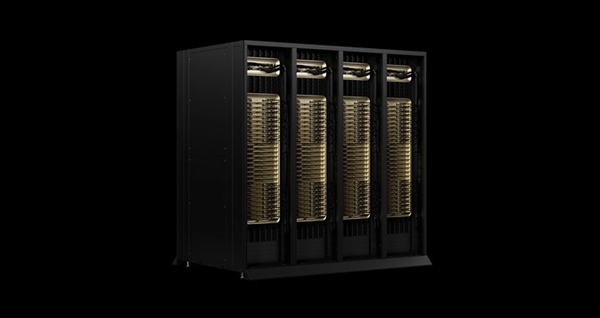Dünyanın en büyük GPU üreticisi olan Nvidia, yapay zeka alanındaki liderliğini pekiştirmek amacıyla yeni nesil çiplerini tanıttı. Şirket, Blackwell Ultra GB300 ve Vera Rubin mimarilerini duyurarak, veri merkezleri ve yapay zeka uygulamaları için sunduğu çözüm yelpazesinde büyük bir adım atıyor.
Blackwell Ultra GB300: Performans ve Bellek Kapasitesinde Büyük Artış

Nvidia’nın Blackwell Ultra GB300 çipi, önceki Blackwell mimarisinin geliştirilmiş versiyonu olarak piyasaya sürülüyor. Bu yeni nesil çip, 20 petaflop FP4 yapay zeka işlem gücü sunuyor ve bellek kapasitesini 288 GB HBM3e’ye çıkarıyor. Bu sayede daha büyük veri setleriyle çalışırken daha hızlı işlem yapabilme imkanı sunuluyor. Ayrıca, DGX GB300 “Superpod” süper bilgisayar kümesi, 300 TB bellek kapasitesi ile 11,5 exaflop FP4 işlem gücü sağlıyor.

Nvidia, Blackwell Ultra’nın FP4 çıkarım işlemlerinde 1,5 kat daha hızlı olduğunu belirtiyor ve bu da yapay zeka uygulamalarında önemli bir hız artışı anlamına geliyor.
Vera Rubin ve Rubin Ultra: Geleceğin Yapay Zeka Çipleri

Nvidia, gelecekteki yapay zeka taleplerini karşılamak için Vera Rubin ve Rubin Ultra adında iki yeni çip mimarisi geliştirdi. Vera Rubin, 50 petaflop FP4 işlem gücü sunarak Blackwell Ultra’nın iki katı performans sağlıyor. Rubin Ultra ise çift GPU tasarımıyla 100 petaflop FP4 performansına ulaşacak. Bellek kapasitesinde de önemli bir artış yaşanacak; Rubin Ultra, 1 TB HBM4e bellek ile Blackwell Ultra’dan neredeyse dört kat daha fazla kapasite sunacak.

Bu yeni nesil çiplerin, veri merkezlerinde ve yapay zeka uygulamalarında hızla büyüyen talepleri karşılaması bekleniyor. Vera Rubin ve Rubin Ultra’nın piyasaya sürülmesiyle birlikte Nvidia, yapay zeka işlemlerinde çok daha hızlı ve verimli çözümler sunmayı hedefliyor.
Nvidia’nın Geleceğe Yönelik Planları: Feynman Mimarisi ve Sürekli Yenilik
Nvidia, her yıl yeni bir yapay zeka çipi duyurmayı planlıyor. Şirketin CEO’su Jensen Huang, yapay zeka devriminde öngörülenin çok ötesinde bir hesaplama gücüne ihtiyaç duyulduğunu vurguluyor ve 2028 yılında piyasaya sürülmesi planlanan “Feynman” adlı yeni GPU mimarisinin bu gereksinimleri karşılamak amacıyla geliştirildiğini belirtiyor. Feynman, ünlü fizikçi Richard Feynman’a ithaf edilecek.
Nvidia’nın yapay zeka çipleri, hızla gelişen veri merkezleri ve yüksek performans gereksinimlerine sahip uygulamalar için kritik bir rol oynamaya devam edecek.
Yeni Teknolojiler ve İş Birlikleri
Nvidia ayrıca, yeni Blackwell Ultra çipini destekleyecek yeni masaüstü yapay zeka bilgisayarları tanıttı. Bu bilgisayarlar, Asus, Dell ve HP gibi büyük markalar tarafından kendi versiyonlarıyla piyasaya sürülecek. Nvidia’nın tanıttığı diğer bir önemli yenilik ise GB300 NVL72 raf çözümü oldu. Bu çözüm, 1,1 exaflops FP4, 20 TB HBM bellek ve 40 TB bellek kapasitesi sunuyor.
Satışlar ve Pazar Performansı
Nvidia, 1.8 milyon Blackwell çipi satıldığını ve bu satışlardan 11 milyar dolar gelir elde ettiğini duyurdu. Bu rakam, Nvidia’nın çip pazarındaki güçlü varlığını ve yapay zeka alanındaki büyük başarısını gözler önüne seriyor.
Nvidia Strengthens Its Leadership in AI with the Introduction of Blackwell Ultra GB300 and Vera Rubin Architectures
Nvidia, the world’s largest GPU manufacturer, has unveiled its next-generation chips to further solidify its leadership in the artificial intelligence (AI) space. The company introduced the Blackwell Ultra GB300 and Vera Rubin architectures, marking a significant step in expanding its range of solutions for data centers and AI applications.
Blackwell Ultra GB300: Significant Boost in Performance and Memory Capacity
The Blackwell Ultra GB300 chip from Nvidia is an enhanced version of the previous Blackwell architecture. This next-generation chip delivers 20 petaflops of FP4 AI processing power and increases the memory capacity from 192 GB HBM3e to 288 GB HBM3e. This improvement enables faster processing when working with larger data sets. Additionally, the DGX GB300 “Superpod” supercomputer cluster comes with a memory capacity of 300 TB and delivers 11.5 exaflops of FP4 processing power. Nvidia claims that Blackwell Ultra is 1.5 times faster in FP4 inference operations, which translates to a significant performance boost in AI applications.
Vera Rubin and Rubin Ultra: The Future of AI Chips
To meet future AI demands, Nvidia has developed two new chip architectures: Vera Rubin and Rubin Ultra. Vera Rubin offers 50 petaflops of FP4 processing power, doubling the performance of the Blackwell Ultra. Rubin Ultra, with a dual-GPU design, will reach 100 petaflops of FP4 performance. Memory capacity will also see a substantial increase, with Rubin Ultra offering 1 TB of HBM4e memory, nearly four times the capacity of Blackwell Ultra.
These next-generation chips are expected to address the growing demands of data centers and AI applications. With the launch of Vera Rubin and Rubin Ultra, Nvidia aims to provide much faster and more efficient solutions for AI processing.
Nvidia’s Future Plans: The Feynman Architecture and Ongoing Innovation
Nvidia plans to release a new AI chip every year moving forward. CEO Jensen Huang emphasizes that the AI revolution requires far more computing power than originally anticipated, stating that “we need 100 times more computational power than we thought last year.” To meet these requirements, Nvidia is developing the “Feynman” GPU architecture, which is set to launch in 2028. The Feynman architecture will be named after the famous physicist Richard Feynman.
Nvidia’s AI chips will continue to play a critical role in rapidly evolving data centers and high-performance applications.
New Technologies and Partnerships
Nvidia also unveiled new desktop AI computers that will support the Blackwell Ultra chip. These computers will be released in versions by major brands such as Asus, Dell, and HP. Another important innovation from Nvidia is the GB300 NVL72 rack solution, which offers 1.1 exaflops of FP4, 20 TB of HBM memory, and 40 TB of total memory capacity.
Sales and Market Performance
Nvidia announced that it has sold 1.8 million Blackwell chips, generating $11 billion in revenue from these sales. This figure highlights Nvidia’s strong presence in the chip market and its significant success in the AI sector.
